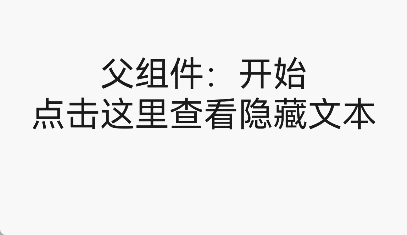自定义组件的基本用法
自定义组件是用户根据业务需求,将已有的组件组合,封装成的新组件,可以在工程中多次调用,从而提高代码的可读性。自定义组件通过element引入到宿主页面,使用方法如下:
<element name='comp' src='../common/component/comp.hml'></element>
<div>
<comp prop1='xxxx' @child1="bindParentVmMethod"></comp>
</div>
结合if-else使用自定义组件的示例,showComp1为true时显示自定义组件comp1,否则显示comp2:
<element name='comp1' src='../common/component/comp1/comp1.hml'></element>
<element name='comp2' src='../common/component/comp2/comp2.hml'></element>
<div>
<comp1 if="{{showComp1}}" prop1='xxxx' @child1="bindParentVmMethodOne"></comp1>
<comp2 else prop1='xxxx' @child1="bindParentVmMethodTwo"></comp2>
</div>
自定义组件的name属性指自定义组件名称(非必填),组件名称对大小写不敏感,默认使用小写。src属性指自定义组件hml文件路径(必填),若没有设置name属性,则默认使用hml文件名作为组件名。
自定义事件
父组件中绑定自定义子组件的事件使用(on|@)event-name="bindParentVmMethod"语法,子组件中通过this.$emit('eventName', { params: '传递参数' })触发事件并向上传递参数,父组件执行bindParentVmMethod方法并接收子组件传递的参数。
说明:
子组件中使用驼峰命名法命名的事件,在父组件中绑定时需要使用短横线分隔命名形式,例如:@children-event表示绑定子组件的childrenEvent事件。
示例1:无参数传递
子组件comp定义如下:
<!-- comp.hml -->
<div class="item">
<text class="text-style" onclick="childClicked">点击这里查看隐藏文本</text>
<text class="text-style" if="{{showObj}}">hello world</text>
</div>
/* comp.css */
.item {
width: 700px;
flex-direction: column;
height: 300px;
align-items: center;
margin-top: 100px;
}
.text-style {
font-weight: 500;
font-family: Courier;
font-size: 40px;
}
// comp.js
export default {
data: {
showObj: false,
},
childClicked () {
this.$emit('eventType1');
this.showObj = !this.showObj;
},
}
引入子组件comp的父组件示例如下:
<!-- xxx.hml -->
<element name='comp' src='../common/component/comp.hml'></element>
<div class="container">
<comp @event-type1="textClicked"></comp>
</div>
/* xxx.css */
.container {
background-color: #f8f8ff;
flex: 1;
flex-direction: column;
align-content: center;
}
// xxx.js
export default {
textClicked () {}
}
示例2:有参数传递
子组件comp定义如下:
<!-- comp.hml -->
<div class="item">
<text class="text-style" onclick="childClicked">点击这里查看隐藏文本</text>
<text class="text-style" if="{{ showObj }}">hello world</text>
</div>
// comp.js
export default {
childClicked () {
this.$emit('eventType1', { text: '收到子组件参数' });
this.showObj = !this.showObj;
},
}
子组件向上传递参数text,父组件接收时通过e.detail来获取该参数:
<!-- xxx.hml -->
<element name='comp' src='../common/comp/comp.hml'></element>
<div class="container">
<text>父组件:{{text}}</text>
<comp @event-type1="textClicked"></comp>
</div>
// xxx.js
export default {
data: {
text: '开始',
},
textClicked (e) {
this.text = e.detail.text;
},
}

自定义组件数据
自定义组件的js文件中可以通过声明data、props、computed等字段完成数据的定义、传递与处理,其中props与computed的具体使用请参考数据传递与处理章节。
表1 自定义组件数据
| 名称 | 类型 | 描述 |
|---|---|---|
| data | Object | Function | 页面的数据模型,类型是对象或者函数,如果类型是函数,返回值必须是对象。属性名不能以$或_开头,不要使用保留字for, if, show, tid。 data与private和public不能重合使用。 |
| props | Array | Object | props用于组件之间的数据通信,可以通过<tag xxxx='value'>方式传递给组件;props名称必须用小写,不能以$或_开头,不要使用保留字for, if, show, tid。目前props的数据类型不支持Function。 |
| computed | Object | 计算属性,用于在读取或设置参数时,进行预先处理,其结果会被缓存。计算属性名不能以$或_开头,不要使用保留字。 |